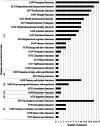From Symptomatology to Functioning - Applying the ICF to Autism Measures to Facilitate Neurodiversity-Affirmative Data Harmonization
- PMID: 38079032
- PMCID: PMC11802640
- DOI: 10.1007/s10803-023-06204-2
From Symptomatology to Functioning - Applying the ICF to Autism Measures to Facilitate Neurodiversity-Affirmative Data Harmonization
Abstract
Purpose: A considerable number of screening and diagnostic tools for autism exist, but variability in these measures presents challenges to data harmonization and the comparability and generalizability of findings. At the same time, there is a movement away from autism symptomatology to stances that capture heterogeneity and appreciate diversity. The International Classification of Functioning, Disability and Health (ICF) provides a classification system that can support content harmonization of different screening and diagnostic tools for autism while enabling the translation of diagnostic information into functioning.
Method: Here we linked commonly used screening and diagnostic measures within the field of autism to the ICF to facilitate the unification of data obtained from these measures.
Results: As expected, screening and diagnostic measures primarily focus on body functions and activities and participation domains of the ICF, and much less on environmental factors, reflecting biomedical and adaptive behavior operationalizations of autism derived from diagnostic manuals.
Conclusion: By translating symptomology-based information to the continuous and diagnostically neutral view of functioning, the ICF linking presented here may provide a means to harmonize measures of autism characteristics while enabling diagnostic information to be re-examined through a more neurodiversity-affirmative lens.
Keywords: Biopsychosocial; Diagnosis; Functioning; Harmonization; Screening.
© 2023. The Author(s).
Figures




References
-
- Adhikari, K., Patten, S. B., Patel, A. B., Premji, S., Tough, S., Letourneau, N., Giesbrecht, G., & Metcalfe, A. (2021). Data harmonization and data pooling from cohort studies: A practical approach for data management. International Journal of Population Data Science, 6(1), 1680. 10.23889/ijpds.v6i1.1680. - PMC - PubMed
-
- Allison, C., Baron-Cohen, S., Wheelwright, S., Charman, T., Richler, J., Pasco, G., & Brayne, C. (2008). The Q-CHAT (quantitative CHecklist for Autism in Toddlers): A normally distributed quantitative measure of autistic traits at 18–24 months of age: Preliminary report. Journal of Autism and Developmental Disorders, 38(8), 1414–1425. 10.1007/s10803-007-0509-7. - PubMed
-
- American Psychiatric Association (2013). Diagnostic and Statistical Manual of Mental Disorders (5th ed.)10.1176/appi.books.978089042559.
-
- Astle, D. E., Holmes, J., Kievit, R., & Gathercole, S. E. (2022). Annual Research Review: The transdiagnostic revolution in neurodevelopmental disorders. Journal of Child Psychology and Psychiatry, 63, 397–417. 10.1111/jcpp.13481. - PubMed
MeSH terms
LinkOut - more resources
Full Text Sources
Medical
Research Materials

